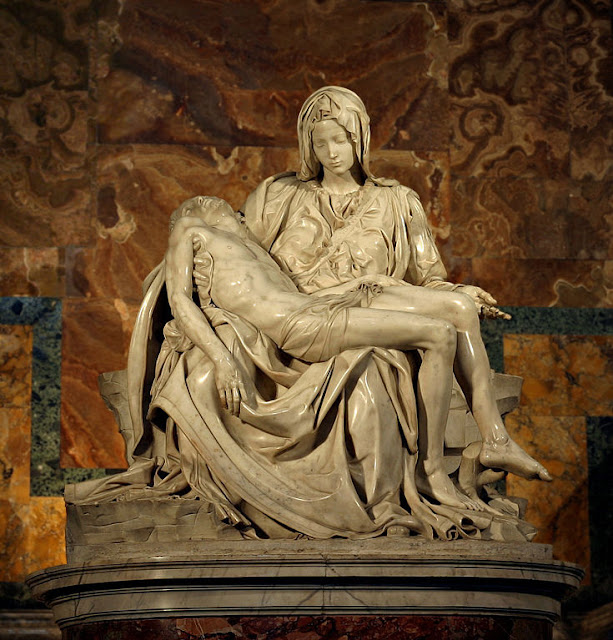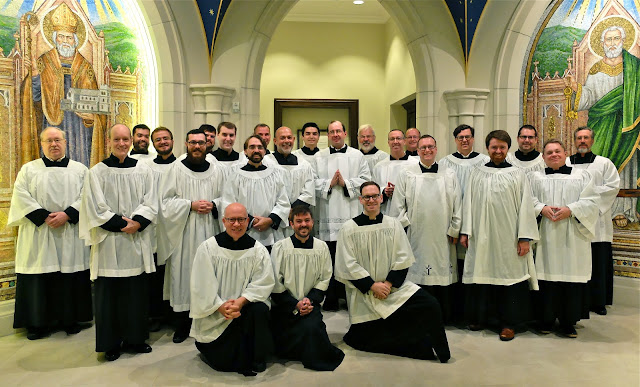Can Rock Concerts Be Worship? One Ordinariate Catholic's Perspective
 |
| (CNS photo/Vatican Media) |
Lights, smoke, an elevated platform, guitars, drums, keyboards, and a large crowd facing the performers. A religious service or a rock concert?
Candles, incense (... maybe), an elevated platform, guitars, drums, keyboards, and a large congregation facing the clergy. Same question.
'Praise and worship' is a label borrowed from evangelical and charismatic Protestant lexicons. The Catholic understands that God desires to be worshipped and praised in the Divine Liturgy. In the Mass, the Catholic can say, "I was gathered into the offering of the Son to the Father. I participated in the self-offering of God today."
God has revealed to us how He wants to be worshipped. Jesus established the model for Catholic worship (St. Matthew 26:17-30). The Latin Rite liturgy has expanded or contracted over the centuries. Universal adjustments were modest until the Bugnini Concilium (1964 - 1969) instituted considerable revisions. A later council of ten faithful experts, the Anglicanae Traditiones Commission, harmonized elements from the Roman and Anglican patrimonies to gift the Church a venerable and beautiful form of the Latin Rite Mass. Divine Worship: the Missal honours the Roman Missal, the English Missal, the Book of Common Prayer, and the ancient Sarum Mass, which served as a significant foundation for the Book of Common Prayer.
- Archbishop Joseph Augustine Di Noia, O.P., Chair of the Commission and Assistant (Adjunct) Secretary of the Congregation for the Doctrine of the Faith.
- Msgr. Steven J. (now Bishop) Lopes (of the Personal Ordinariate of the Chair of Saint Peter), Coordinating Secretary of the Commission and a member of the Congregation for the Doctrine of the Faith
- Msgr. Andrew Burnham of the Personal Ordinariate of Our Lady of Walsingham
- Auxiliary Bishop Peter J. Elliott (R.I.P.) of the Archdiocese of Melbourne
- Archbishop Salvatore Joseph Cordileone of the Archdiocese of San Francisco
- Father Uwe Michael Lang of the Congregation of the Oratory of Saint Philip Neri in London
- Dr. Hans-Jürgen Feulner of the University of Vienna, Austria
- Dr. Clinton A. Brand of the University of St. Thomas of Houston, Texas
- Father Andrew Menke, Associate Director of the U.S. Conference of Catholic Bishops’ Secretariat of Divine Worship and former staff member of the Congregation for Divine Worship and the Discipline of the Sacraments
- Consulter Msgr. Peter Wilkinson of Victoria, British Columbia, Canada
Divine Worship: The Missal preserves such features and elements that are representative of the historic Anglican Books of Common Prayer and Anglican missals, in conformity with Catholic doctrinal and liturgical norms, and is therefore at once distinctively and traditionally Anglican in character, linguistic register, and structure, while also being clearly and recognizably an expression of the Roman Rite. / Divine Worship p. 121
Many older Catholics, perhaps those who wore guitars and let their hair down in the 1970s, believe that young people today still prefer pop music to ritual, sacred music, and silence, yet this assumption may be conceived through a hazy lens. With access to internet resources, a younger generation is becoming well-versed in traditional ritual and Church history, and they are only satisfied with authentic Catholicism, historical Catholicism.
What I saw at many of these charismatic events frankly concerned me, it did not appear to be Catholic, nor Biblical, it was purely hyped up emotionalism. The power and objective grace of God comes to us through 'Ritual' (i.e., the Holy Catholic Mass), not emotion. The Old Testament Israelites also received the grace and blessing of God through ritual not displays of emotional outburst.
Emotions cannot sustain a Christian, that is why wherever you see the Catholic Charismatic renewal practiced, everyone is bald or has grey hair. It’s not reproducing itself, young people are not coming, they are not attracted to these effusive displays of emotionalism. A spinoff of the CCR is the ‘Life Teen’ Mass and movement, it has 3 flat tires. The facts are clear, the Catholic Charismatic Renewal is on life support. As a result, I have personally moved into a more orthodox, apostolic and traditional practice of Catholicism many years ago. - Jesse Romero, B.A. (Mount St. Mary’s College), M.A. (Steubenville), Catholic bilingual author, radio host, lay evangelist.
This convert blogger, having inhabited both protestant and Catholic charismatic circles, agrees with Mr. Romero's observations. Emotionalism, be it manifest in evangelical or charismatic gatherings, is a concern and a distraction.
While many young people attend major outdoor festivals, their liturgical spirituality is evident in their choice of traditional liturgy when they are at home or where access is available. Sadly, too many clergy are slow to see the trend, which, despite various attempts to constrain traditional liturgical practices by bishops and archbishops, cannot be contained.
In the Sacred Liturgy, Jesus Christ invites us into communion with the Holy Trinity—Father, Son, and Holy Ghost. Mystery! Spectacle, on the other hand, holds us at bay, leaving us fixated on emotion, and trapped in our senses instead of led through our senses and passions by Jesus into the mystery of love, the mystery of God.
Apples and Oranges
A rock concert wrapped up in vestments, as a paraliturgical event, might better be described as a religious spectacle or, perhaps using a less contentious term, a contemporary form of the Office. The Divine Office, a.k.a. the Liturgy of the Hours, or the Breviary, which are non-Eucharistic—unless Benediction of the Blessed Sacrament is offered—often serves as a framework, albeit a loose one. A blending of traditional elements with contemporary expressions can create an opportunity that resonates with both the faithful and those exploring spirituality. That said, a form of the daily prayer of the Church, Divine Worship: the Office, as it is found in the Personal Ordinariates, is finding extraordinary acceptance in the wider Church because of its richness and depth, clarity, and beauty. The Ordinariate Office preserves the "hinges" of the day, Mattins (Morning Prayer) and Evensong (Evening Prayer), from the Anglican experience.
Large outdoor gatherings or stadium praise and worship gatherings are probably preferable to large outdoor Eucharistic liturgies. The risk of profanation of the Holy Eucharist is too high. How many times have news commentaries appeared detailing carelessness and mishandling of the Eucharist at large outdoor gatherings?
- Tupperware tabernacle: https://catholicweekly.com.au/wyd-tupperware-tabernacles-call-for-a-eucharistic-revival/
- https://www.catholicnewsagency.com/news/261115/priest-prevents-desecration-of-the-eucharist-during-mass-in-honduras
- https://www.youtube.com/watch?v=dmS7l601J1I
Is it possible to have large and respectable outdoor liturgies? Indeed it is possible, but those who are responsible for the distribution of the Body of Christ should be restricted to deacons and priests, and reception should be restricted to communion on the tongue. This approach not only safeguards the sanctity of the sacrament but also reinforces the reverence that should accompany such a profound act of faith. By ensuring that only ordained ministers handle the Eucharist, the community can foster a deeper respect and understanding of its significance.
Candles, incense, a sanctuary, a raised altar, an altar rail, a pipe organ, and a congregation facing in the same direction as the clergy (ad orientem). Renewal now.
Additional reading: https://www.hprweb.com/2015/11/sacred-liturgy-great-mystery-great-mercy/
.jpg)





Comments
Post a Comment
Your comments will be appreciated and posted if 1) they are on topic and 2) preserve decorum.
Stand by your word.